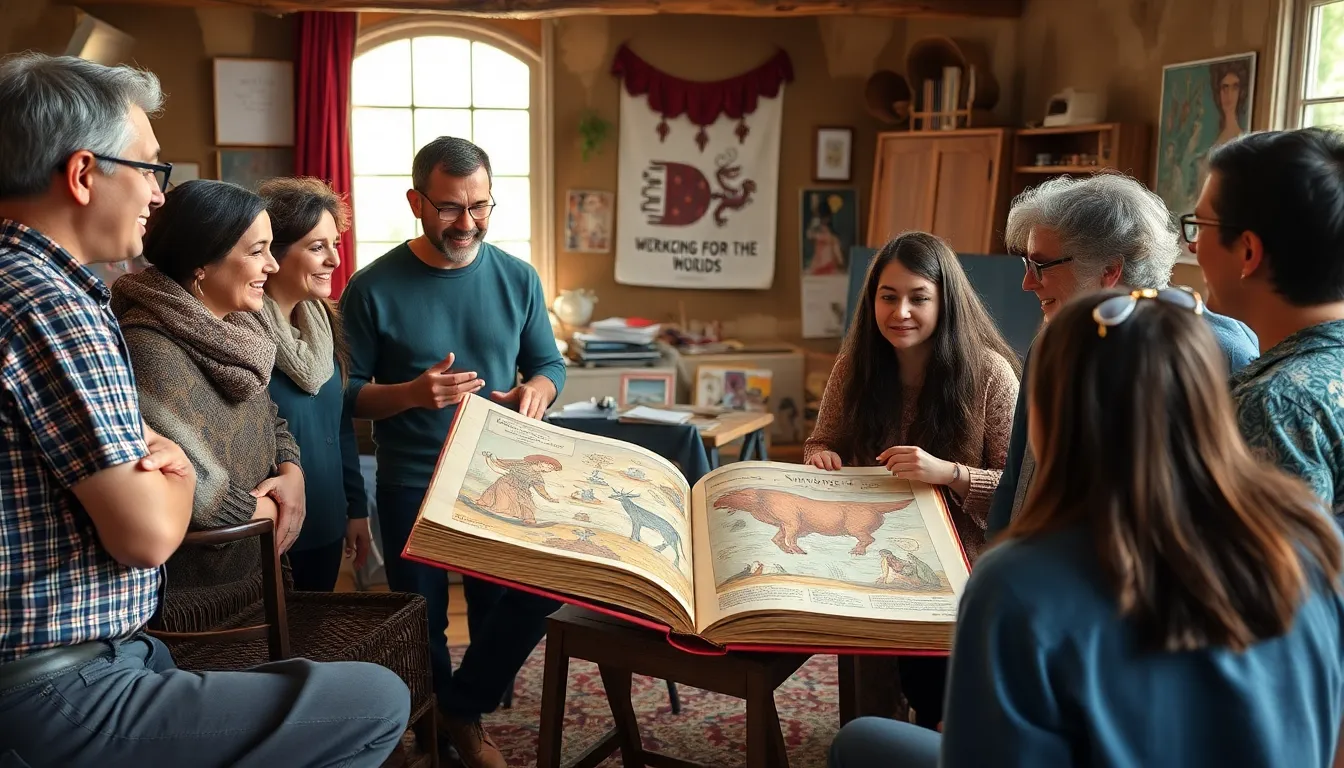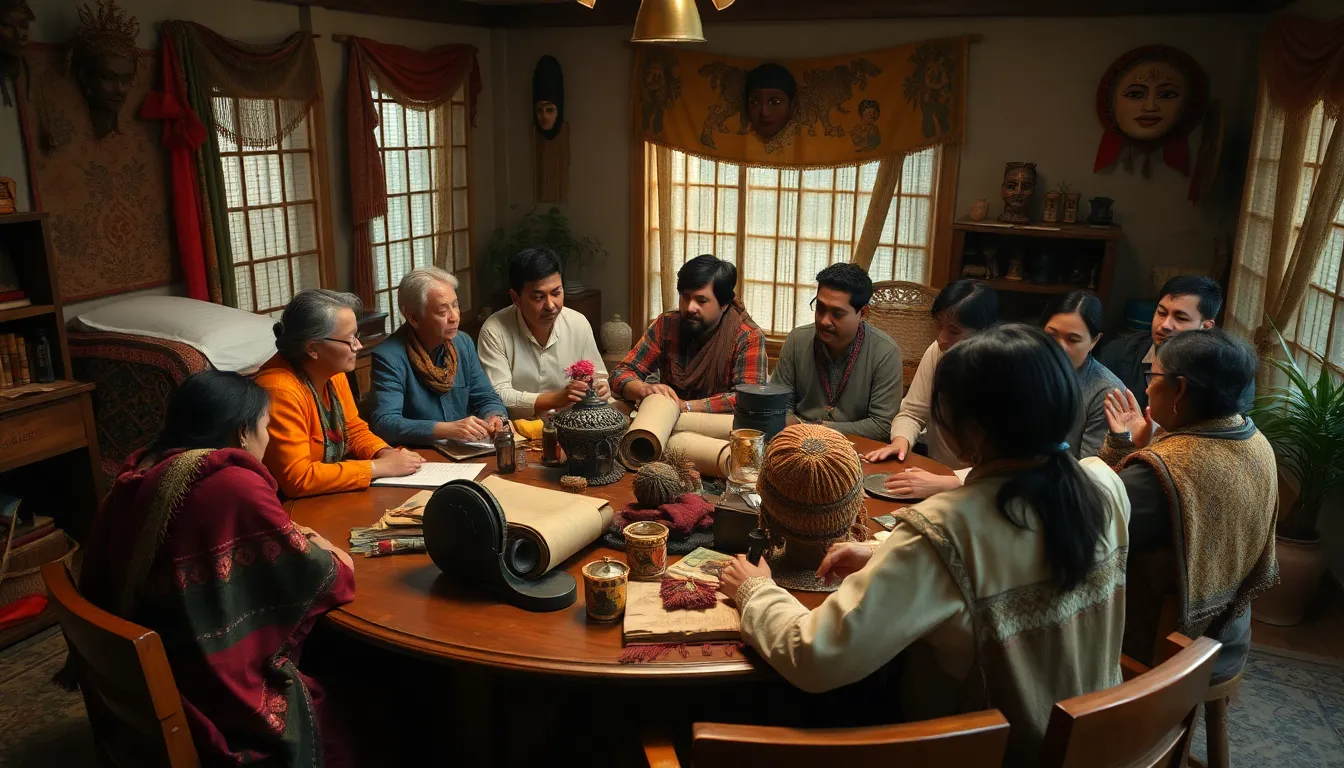Table of Contents
ToggleNonlinear storytelling traditions have a knack for bending time and space, turning the conventional narrative on its head. Imagine diving into a story where the end is just the beginning, and characters pop up like surprise guests at a party. This approach keeps readers on their toes, making them piece together the puzzle while they chuckle at the unexpected twists.
From ancient myths to modern films, nonlinear narratives have captivated audiences, proving that sometimes the best way to tell a tale is to zigzag through time. These unique storytelling techniques invite creativity and challenge the norm, transforming how we engage with stories. So buckle up, because exploring nonlinear storytelling is like taking a wild ride through the funhouse of literature, where every turn reveals something new and delightful.
Overview of Nonlinear Storytelling Traditions
Nonlinear storytelling encompasses various traditions that explore unique narrative structures. Cultures throughout history have utilized nonlinear techniques to engage audiences in innovative ways. In ancient mythologies, such as those from Greece and India, stories often unfold out of chronological order, allowing for a rich tapestry of interwoven themes and characters.
In literature, works like “One Hundred Years of Solitude” by Gabriel García Márquez exemplify nonlinear techniques through fragmented timelines and multiple perspectives. Similarly, modern novels frequently incorporate flashbacks and alternating viewpoints. Television series and films now adopt nonlinear storytelling to captivate viewers. Shows like “Westworld” and films such as “Pulp Fiction” demonstrate this trend by intertwining various timelines and plotlines.
Interactive media, including video games, also utilize nonlinear structures to enhance storytelling. Players often experience narratives through choices that affect outcomes and character development. This interactivity fosters a deeper connection with the story.
Nonlinear storytelling traditions challenge conventions by offering alternative ways to craft narratives. These approaches encourage audiences to piece together disjointed events, creating a more active engagement. The exploration of time and space in narrative forms provides ample opportunities for creativity.
Scholarly analysis of nonlinear narratives sheds light on their cultural significance. Researchers examine how these structures reflect societal values and psychological complexities. As nonlinear storytelling continues to evolve, its impact on various media reinforces the versatility and appeal of this narrative style.
Historical Context

Nonlinear storytelling traditions have deep roots in various cultures, revealing how narratives have evolved over time. This exploration highlights two significant aspects: ancient storytelling practices and modern influences.
Ancient Storytelling Practices
Ancient myths from cultures like Greece and India often employed nonlinear structures. Greek tragedies, for instance, frequently presented events out of chronological order, intriguing audiences with their complex plots. Indian epics, such as the Mahabharata, also showcase fragmented timelines, weaving together multiple narratives that enhance thematic depth. Oral traditions further contributed by allowing storytellers to manipulate time, creating layered experiences that engaged listeners. These practices not only entertained but also conveyed moral and philosophical lessons, establishing a foundation for future storytelling forms.
Modern Influences
Contemporary storytelling borrows heavily from these ancient practices. Films like “Pulp Fiction” demonstrate how nonlinear narratives can create suspense and unpredictability, drawing viewers into intricate plots. Television series such as “Westworld” utilize complex timelines that invite viewers to piece together the narrative puzzle. Interactive media, especially video games, further enhance nonlinear storytelling by allowing players to make choices that shape story outcomes. This modern evolution reflects a shift toward immersive experiences that engage audiences in ways traditional forms may not. Nonlinear techniques provide a fresh approach to character development and narrative structure, pushing the boundaries of storytelling.
Key Characteristics of Nonlinear Storytelling
Nonlinear storytelling captivates audiences by defying traditional narrative structures. This approach often includes diverse techniques that enhance engagement.
Structure and Narrative Techniques
Story structure deviates from linear progression, allowing for various timelines and perspectives. Flashbacks and flash-forwards help reveal critical information, creating suspense. Fragmented narratives offer multiple threads, weaving them together in unexpected ways. Nonlinear techniques encourage participation, inviting audiences to piece together the storyline. Some narratives jump between time periods, providing richer context. By using unreliable narrators, storytellers craft layers of meaning through ambiguity.
Themes and Motifs
Central themes often revolve around memory, identity, and the fluidity of time. Exploration of characters’ pasts influences their present circumstances, highlighting emotional depth. Various motifs, such as cycles and parallels, reinforce connections between disparate events. Recurrent symbols promote a cohesive understanding across fragmented timelines. Nonlinear storytelling invites reflection on human experience, emphasizing the subjective nature of reality. By integrating contrasting perspectives, storytellers evoke empathy and intrigue, making audiences active participants in uncovering the narrative’s significance.
Notable Examples of Nonlinear Storytelling
Numerous works exemplify nonlinear storytelling across various mediums. Highlighting this diversity, several notable examples from literature and film emerge.
Literature
Gabriel García Márquez’s “One Hundred Years of Solitude” features a nonlinear timeline that challenges readers with its fragmented narratives and shifting perspectives. In this novel, time bends as characters experience events out of order, creating rich layers of meaning. Similarly, “The Sound and the Fury” by William Faulkner employs stream-of-consciousness techniques, allowing readers to perceive events through multiple character viewpoints. Another compelling example comes from “Slaughterhouse-Five” by Kurt Vonnegut, where the protagonist experiences time non-sequentially, reflecting on the absurdities of war. These literary works illustrate the power of nonlinear structures to convey complex themes of memory and identity.
Film and Television
Films like “Pulp Fiction” and “Memento” redefine traditional storytelling through their innovative structures. “Pulp Fiction” features intersecting storylines that unfold out of chronological order, creating a dynamic viewing experience full of surprises. Meanwhile, “Memento” utilizes reverse chronology, compelling viewers to piece together the narrative as it progresses. In television, series such as “Westworld” and “The Haunting of Hill House” intertwine multiple timelines, encouraging audience engagement and speculation. Such techniques not only enhance the narrative but also immerse viewers in the storytelling process, showcasing the effectiveness of nonlinear formats in modern media.
The Impact of Nonlinear Storytelling on Audience Engagement
Nonlinear storytelling significantly boosts audience engagement by reshaping traditional narrative structures. By presenting stories out of chronological order, creators can surprise audiences with unexpected twists. Cultures have long utilized this technique; ancient myths often employed disjointed timelines to maintain interest.
Engagement intensifies when narratives invite participation through unforeseen connections among events. This interactive quality encourages active involvement, making viewers or readers co-creators of the narrative experience. For example, television shows like “Westworld” keep viewers guessing as they piece together fragmented timelines, enhancing suspense.
Emotional connection represents another key factor in nonlinear storytelling. By integrating multiple perspectives, stories resonate more deeply with audiences, fostering empathy. Characters’ journeys reveal the complexity of memory and identity, engaging viewers on a personal level.
Innovative formats also enhance engagement. Nonlinear storytelling in video games allows players to shape outcomes through choices, creating a truly immersive experience. As players navigate through fragmented narratives, they develop personal connections with characters and events.
Alternative structures can enhance thematic depth. Nonlinear narratives often explore themes of time’s fluidity and the reliability of memory. This exploration challenges audiences to reflect on their own experiences, drawing parallels between personal and narrative journeys.
Engagement also flourishes within literature. Works like “The Sound and the Fury” and “One Hundred Years of Solitude” utilize nonlinear formats to explore complex themes. These narratives heighten curiosity, as readers unravel layered stories that span generations.
Nonlinear storytelling transforms audience engagement. By embracing innovative structures, creators challenge perceptions, evoke empathy, and invite interactivity, leading to a richer narrative experience.
Nonlinear storytelling traditions continue to thrive across cultures and mediums. By breaking free from chronological constraints, these narratives invite audiences to engage more deeply with the material. They foster emotional connections and provoke thought, encouraging viewers and readers to reflect on their own experiences.
As creators explore innovative formats, the potential for nonlinear storytelling grows. This approach not only captivates but also challenges traditional norms, offering fresh perspectives on time, memory, and identity. Embracing nonlinear narratives enriches the storytelling landscape, making it a vital aspect of contemporary literature, film, and interactive media.








